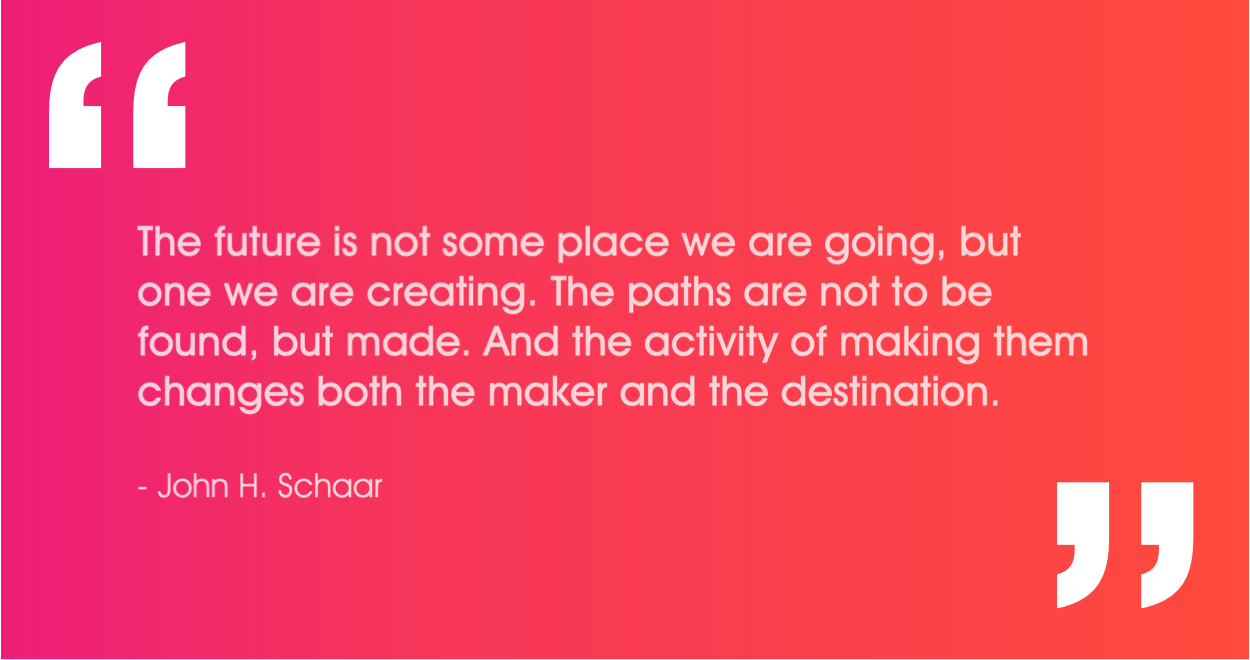Creating a future of opportunity in a world of uncertainty.
Leadership Blog | 5 minute read

Written by Mike Straw

There’s no fate but what we create.
How should leaders lead in today’s uncertain times? Planning seems impossible, the rules keep changing and no one can be sure what the ‘new normal’ really looks like. Unprecedented is perhaps the most over-used word of 2020, but clearly there is a high level of uncertainty today. But uncertainty has always been part of business, and indeed of life. The danger for leaders is that they allow uncertainty to become their dominant context. It is easy to become overwhelmed in such circumstances and for individuals, teams and entire organisations to become trapped by the assumptions they make. Leaders need to change the context and become authors of their own narrative.

Conventional thinking says when faced with uncertainty you should ‘stick to the knitting’ and mitigate risk. We pull back on aspiration, focus on getting by and prepare for the worst. But these actions are self-limiting – for example, businesses that furloughed staff in anticipation of falling demand, but were then unable to meet actual demand and lost business. By trying to exert and extend control in the face of uncertainty leaders get sucked into simply playing a part in a narrative they don’t own.
Facts or Assumptions?
That’s not to say that uncertainty isn’t real, and doesn’t present issues, but leaders need to challenge the assumptions that come with it. This is not a matter of positive thinking, or ostrich-like denial – but it is checking that facts are indeed facts. Twelve months ago it was a ‘fact’ that it took a decade or more to invent, test and introduce a new vaccine – yet this month COVID-19 vaccines will be offered less than a year after the pandemic started. You could argue that vaccine researchers weren’t starting from scratch, governments have substianally funded R&D, ect, ect - but the point is the same timelines have collapsed and what is now possible is very different. What was considered to be a fact was just an assumption. One of the silver-linings of the pandemic has been the ‘assumption revolution’ which has seen deeply held views of what’s possible smashed as businesses commit to do whatever was necessary to deliver on bold commitments.
The Future’s What You Make It
And this is the role for leaders today. The future is neither a concrete thing, not a destination to which we are inexorably journeying. It is context that we chose to create for ourselves and which will shape what we think is possible. Context is powerfully decisive in shaping the assumptions that control decisions and actions. Allowing a context of uncertainty to dominate will hamper any efforts to break free and maximise opportunity. The fundamental role of leadership is to fully perceive and understand current context, and then proactively work to create a new, more powerful context that moves the organisation forward. Three aspects of breakthrough thinking are invaluable to leaders seeking to accomplish this.
One: Tune In
Leaders must tune in to the little voices in their heads and those of the people around them. What is our gut instinct telling us about the situation? What are the opportunities that we see, but almost instantly dismiss as impractical, too risky or not right for today’s market? Get these inner thoughts and wishes out on the table and really look at them. They are the clues to understanding the context that is invisibly shaping your decisions and responses.
Two: Challenge
Challenge the assumptions that are holding you back –are they facts, or just habits or accepted truths? Is it really impossible to do that – have we ever tried? What could we do, and what would happen if we did? As part of this process it is important to jettison old language as well as ingrained ways of thinking. We naturally define innovation in terms of what has gone before, but this reinforces context. E-payment apps on smartphones are called digital wallets because they provide a familiar reference. But they are nothing like wallets and thinking of them as such actually limits their potential. Stepping outside of the existing context and its language frees leadership to consider new opportunities and approaches that could be the keys to a better and brighter future.
Three: Commit
Leaders commit 100% to their vision. They believe in planning, but not in plans. Full commitment means that they will do whatever it takes to get to the goal. Plans may change, hit breakdowns or be torn-up – they are a means to an end, but the commitment never changes. Employees, teams and whole organisations see this and naturally are drawn to add their commitment to the shared goal. To fully commit leaders should live in the result. That means committing to more than a recovery plan but instead to a new, defined possibility where opportunity has been realised.
Leaders can choose to be dominated by a context of uncertainly or inspired to create a context of opportunity. Heeding the little voice inside will give them the clues to the context that’s shaping their reactions and those of their organisations. Understanding and then stepping outside of this context gives them space and clarity to challenge assumptions that are holding them back. Seeing the situation clearly allows the leader to commit to a bold vision and create a new context and future of opportunity.
Collectively these steps help shift mindsets and open our eyes to opportunity. Fundamentally, they give leaders the power to become authors of their own future. No longer driven from decision to decision hopelessly trying to keep up with someone else’s script they can shift from trying to control uncertainly and manage change to become the authors of their own destiny. As Sarah Connor says at the end of The Terminator movie “There’s no fate but what we create.” Leaders should adopt this mantra as they step outside uncertainty and create a future of opportunity.
Published 11/12/2020
Subscribe by Email
Achieve more breakthroughs. Get expert leadership ideas, insights and advice straight to your inbox every Saturday, as well as the occasional bit of news on us, such as offers and invitations to participate in things like events, webinars and surveys. Read. Lead. Breakthrough.
Tags
- Attracting talent
- Behaviour change
- Blended Learning
- Breakthrough Thinking
- Business partnering
- Career planning
- Change management
- Collaboration
- Communication
- Competitive strategy
- Creativity
- Decision making
- Developing middle management
- Developing millennials
- Developing talent
- Employee engagement
- Entrepreneurship
- High performing teams
- Hiring
- Human Resource Management
- Innovation
- Leadership development
- Learning technology
- Managing people
- Managing uncertainty
- Managing yourself
- Mergers & Acquisitions
- Mindset
- Motivating people
- Negotiation
- Organisational culture
- Organisational development
- Organisational values & purpose
- Performance management
- Productivity
- Programme Management
- Retaining talent
- Strategic thinking
- Strategy
- Strategy execution
- Succession planning
- Team development
- Work-life balance
Related posts
Leadership Blog
What triggers you as a leader, and how to work with it?
Achieve Breakthrough | 09/12/2025
Leadership Blog
Why it’s impossible to lead with one foot still in your old role
Achieve Breakthrough | 03/12/2025
Leadership Blog
Why a leader’s true value lies in what they enable, not just what they know
Achieve Breakthrough | 25/11/2025
Leadership Blog
Holding steady through leadership transitions
Achieve Breakthrough | 19/11/2025
